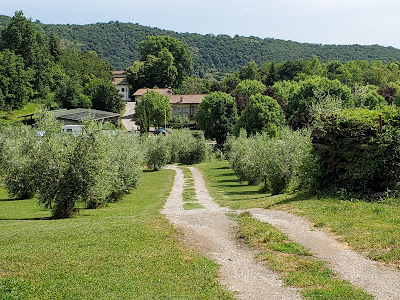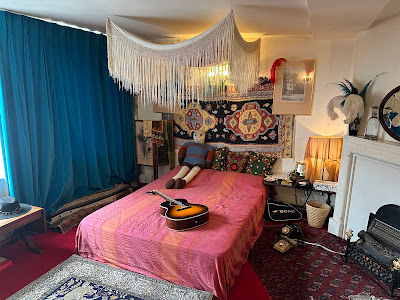 |
| View from our room in Capo de Ponte, Italy. |
In early June, after spending four days in Milan, we rented a car and did a short driving trip to the Italian Alps. It was a trip we had done before, in February 2003. This time, the weather was warmer, days longer, and we spent more time in the Valle Camonica. We started in Bergamo, just an hour or so north of Milan.
 |
| Looking over the city walls, Bergamo, Italy. |
Bergamo dates back to Roman times, when it was known as Bergamum. It has two parts, a lower city on the flat plain, and the Citta Alta, or upper city, perched on a hill and surrounded by an ancient wall. The cobblestone streets in this medieval city are narrow and there is almost no available parking. On the advice of our hotel, we parked in the underground parking structure, took the elevator to the top, and bumped our suitcases over the cobblestones for the seven-minute walk to our hotel.
 |
| Evening's bread supply for the hotel restaurant. |
 |
| View from our room in Bergamo. |
There we climbed the steep stairs to our room on the top floor of the building, which, we were told, dates back to the fourth century. Our room looked over the hotel restaurant patio below.
 |
| The Citta Alta, Bergamo. |
Most tourists come to the Citta Alta just for the day and arrive by funicular from the lower city. In addition to its historic churches and museums, the Citta Alta has one long shopping street lined with restaurants and shops--pizza, pastries, gelato, candies, souvenirs, clothing, jewelry—you name it.
 |
| Sweets for sale, Bergamo. |
 |
| Puppet theater. |
Among my favorite shop windows was one featuring animal masks. I was also intrigued by a book shop with a small puppet stage displayed in its window. When I was a child I would have loved to have had such a puppet stage
 |
| Mother and baby wooly mammoth models, Natural Science Museum, Bergamo. |
The main focus of our visit to Bergamo was the natural history where we paid a visit to Eudimorphodon, the pterosaur fossil that was featured in my book Pterosauars: Rulers of the Skies in the Dinosaur Age, and to the wooly mammoth model, also a subject of one of my books. See my post at my Art and Books blog about the fossil and diorama of Eudimorphodon. We also visited the historical museum in Bergamo, where there are exhibits about the long human history in northern Italy, from prehistoric to Roman times to the present.
 |
| Prehistoric rock engravings, Naquane National Park. |
From Bergamo we headed north into the Alps to the Valle Camonica, where our goal was to visit Naquane National Park to see the ancient petroglyphs.
 |
| Rock with prehistoric engravings, Museum in Cemmo. |
Our first stop was at the local museum, which provided a preview and information about the discoveries in the Valle Camonica. The ticket was also good for both the Naquane park entrance and another museum. At the park entrance we got a map that guided us to the major petroglyph sites. There wooden walkways allowed a close-up view of the images and sign-boards in both Italian and English explained the significance of the carvings.
 |
| View from our room at the Casa Visnenza B&B, Capo de Ponte. |
In Capo di Ponte we stayed in a B&B tucked in the hills above the river valley. As I gazed out the window I felt like I had become part of a Renaissance painting. Over a hearty breakfast we got to know some of the other guests and the owner, whose mother had grown up in the house (the youngest of six children). She was very helpful in advising us where to go and what to see. The valley is filled with history and numerous tracks and hiking trails.
One evening, on a short walk, we met a curious pair of donkeys and their foals along the carriage track up the mountain behind our B&B.
 |
| Olive orchard and farmhouse at Agriturismo La Tesa hotel. |
From Capo di Ponte we drove down the west side of Lake Iseo (through many tunnels!) to the resort town of Iseo, where we stayed for one night in a agritourism hotel in the hills above the town. The original farmhouse is now a hotel and restaurant. The olive orchard and berry vines are still maintained and part of the grounds. (Robot lawn mowers keep the grass perpetually trimmed.)
 |
| Overlook of Lake Iseo from Agriturismo La Tesa hotel. |
A short walk from the La Tesa hotel leads to the top of the escarpment with a panoramic view of Lake Iseo and Isla Isola.
 |
| Hotel Villa Malpensa, Milan airport. |
Our last night in Italy was spent at a hotel near the airport. From the window of our room we could see the airplanes taking off just a mile away. But rather surprisingly, the hotel felt rural, surrounded by fields and next to a small village.
 |
| Tower behind Hotel Villa Malpensa. |
As we took a walk after dinner that evening we discovered a strange tower that looked like the perfect setting for “Rapunzel, Rapunzel, let down your hair!” Apparently, it was built as some sort of silo, or grain storage tower.
During the entire trip to Italy we relied on our GPS
for both walking and driving. We wonder how we ever managed to find our way on our previous
trips to Italy, before GPS was invented! We must have relied on paper maps and
verbal directions!
 |
| Path between petroglyph sites in Naquane National Park. |
We always enjoy travelling to Italy and have been there numerous times—summer, fall, winter, spring. This was our first trip in June, and although the weather was warm, only two days were truly hot (above 90 degrees F.) and we had almost no rain. It was also the beginning of high tourist season, so popular sites like the Duomo in Milan and the main street of the Citta Alta in Bergamo were crowded. But our trip to the Valle Camonica was enough off the beaten track that we felt we had escaped the crowds. It was a good trip.
 |
| At the entrance to Naquane National Park. |
My report of the first part of our trip, in Milan, posted on June 30, 2025.





































